How Do Book Reviewers Approach Your Book?

Intro
I have to give credit for the idea for this post to Twitter user @RebeccaJBradley who showed up on my Twitter feed with this Tweet:

This made me think that it would be fun to go back and reexamine some of my old favorites and how I approached them originally. Because I love doing statistics stuff, despite having majored in a humanities-based field in college. So I went back through my Goodreads and looked at my books and examined some of the ways I came to read some books. I figured these statistics could come in handy for authors who are looking at ways to get their books into reviewers’ hands, so here we go!
But I had to set a few rules first.
Rule #1: We’re only looking at standalones or book #1 in a series.
There’s quite a few long-running series (side-eyes my large collection of Erin Hunter books) that I’ve read where, if I were to include every single book in that series, it would mess up all the numbers. So for the purposes of this exercise, we’ll only be looking at books that either are standalones or that are book #1 in a series.
Rule #2: No manga or graphic novels
Again, for the purposes of this exercise, we’re going to ignore all manga and graphic novels. Yes, I do count them as real books, but again, including all that manga I’ve read would mess up the stats, mostly for the adaptations, because a lot of manga I’ve read was because I watched the anime first. So for simplicity’s sake, we’ll just do fiction novels and novellas that are written primarily in prose. (though illustrated novels are okay)
Rule #3: We’re ignoring DNFs
Mostly because, while doing this exercise, I went through all the books I’ve marked as “read” on Goodreads, and on my Goodreads, I have a completely separate DNF shelf (for those who are unaware, DNF stands for Did Not Finish) So we’re only looking at books I’ve finished to the very last page.
After taking into account these rules, I was left with 225 books to analyze.
The first thing I did was to make a list of every single book that would count for this exercise and write the title and a quick note about why I picked it up in the first place. (Also while doing this, I kept them organized by star rating, so the first page was 5 star books, the second page was 4 star books, the third page was 3 star books, etc.) It ended up looking like this:

After that, I made another list (there’s a theme here: lists xD) of all the common reasons I had noted. If you would like to jump around on this page, use CTRL + F (or Command + F if you’re on a Mac) to search for the terms in bold.
I read it after watching the movie/TV adaptation (CTRL + F: Adaptation)It was a book from my childhood I remembered and reread it for nostalgia (CTRL + F: Childhood)It was a backlist/new release from a favorite author (CTRL + F: Favorite author)A friend or family member told me to read it (CTRL + F: Word of mouth)I found it while randomly browsing at the library or thrift store (CTRL + F: Chance find)The Amazon or Goodreads algorithm brought it to my attention (CTRL + F: The Almighty Algorithm)The author is famous for some other reason and I read their book to support them (CTRL + F: Platform first)I read it because it was hyped on Booktube, Booktok, Twitter, etc. (CTRL + F: Hype)I received it as an ARC after being contacted by the author/publisher (CTRL + F: ARC)Other reasons that don’t cover the above nine reasons (I’ll explain when I get there) (CTRL + F: Other)Conclusion (CTRL + F: Conclusion)Finally, I went through all the books I read for each reason and made some statistics-based observations that I now want to share with you here. So without further ado, let’s get into it!
Reason #1: Adaptation
It feels appropriate to start with this because one of my favorite books of all time, Lord of the Rings, came into my life because I watched the movies first and wanted to read the source material. And I at first thought “Naw, there’s not that many of them,” but then I kept looking and found quite a few.
For this reason, I looked specifically at books where I watched the adaptation before picking up the book.
From the list I mentioned above, I had 23 books that fit this requirement. Most of them were movie adaptations, a few were TV adaptations, and one I have to mention also that I included was Arrows of the Queen by Mercedes Lackey, which I read after encountering the Songs of Valdemar that she also wrote. (if you’re curious about that, just hop over to Youtube and search “Mercedes Lackey song” and you’ll figure it out) The following pie chart shows the star rating of all 23 books I read because of their adaptation:
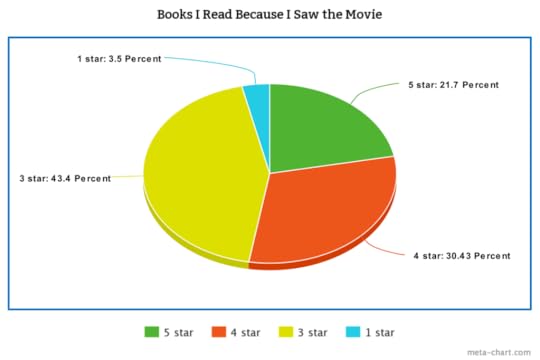
(Note: none of the books I read because I saw the movie first ended up being a 2-star rating, thus, 2-star does not appear in the above chart)
I also looked at how much time passed between me seeing the movie/adaptation and picking up the source material (book).
Read the book within six months of seeing the adaptation: 2
Read the book six months to a year after seeing the adaptation: 2
Waited a year or more before reading the book: 19
I also looked at a very important factor, which is when it comes to enjoying the story, do I prefer the movie or the book?
Of the 23 books, the ones I think were pretty good adaptations but work better as books, are The Hunger Games, Arrows of the Queen, Howl’s Moving Castle, and The Melancholy of Haruhi Suzumiya.
The Lord of the Rings and The Lord of the Rings: Weapons and Warfare are two where I can’t decide if the movie or the book is better; the movie did such a great job telling the story but also improved on it so much that I love them both equally and for different reasons.
The remaining 16 books (we’re disregarding the one book that I rated one star) are ones where I prefer the movie over the book. I also noticed that the adaptations that I thought improved on the story of the book/that I prefer as movies or TV shows were ones where I waited 1+ year after seeing the adaptation to go back and read the original story. Take of that what you will. (In fact, I want to do another post in the future talking about books that I thought were better as movies and why!)
Reason #2: Childhood nostalgia
For the purposes of this exercise, we’re going to count “child” as anything before 10 years old. Out of the 225 books I analyzed on Goodreads, I counted seventeen that I read and enjoyed when I was still just in the single digits in terms of age. Seven of them were five stars, nine of them were four stars, and only one of them was a three-star read; none of them were 2 or 1 star. That’s rather to be expected; if I remember it from my childhood enough to go back and reread it as an adult, it would have to be one I enjoyed!
And here’s the pie chart for all you suckers:
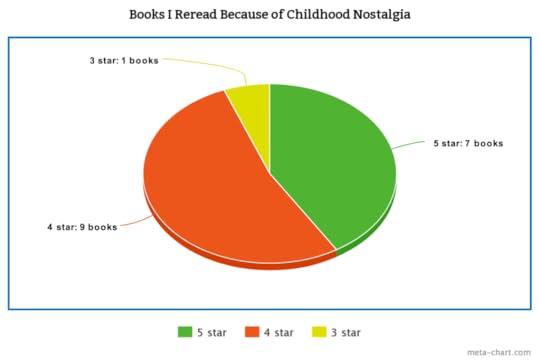
For this one, I couldn’t parse anything like how much time had passed between reading it as a child and then picking it back up as an adult or anything like that, but I did look at what genre they were. (It shouldn’t even be worth mentioning that these are all middle-grade, children’s, etc. books!)
Of the seventeen childhood rereads, 4 of them were fantasy, 5 of them were historical fiction, and 8 of them are contemporaries for their time. (eg. Charlotte’s Web, The Egypt Game, etc.)
Reason #3: Favorite author
Of my 225 books, I found eighteen that were either new releases or backlist titles from authors that I’d already read one or more books of theirs and knew I would like their writing style. (Remember: this is not including sequels to series that I wanted to continue, things like that! If we were to include series/sequels, we’d be here all day!)
You suckers really seem to be enjoying these pie charts, so… *waves pie chart wand*
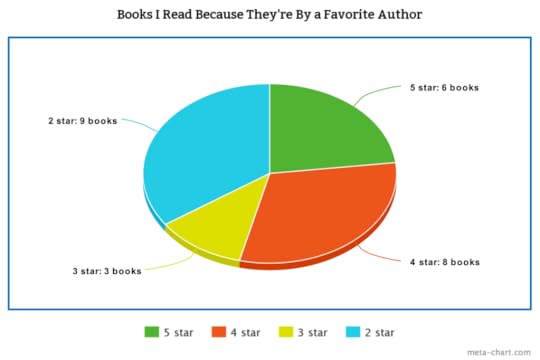
I also wanted to look at how many authors this entailed. The pie chart above depicts eighteen books written by nine individual authors. Of those books, five of them were book #1 in a series which I do want to/have continued and seven authors were ones I would want to pick up a third, fourth, etc. book by them. (two authors I have read multiple books by them but have since given up on them: one was an author who got a 4-star rating from me on the first book of theirs I read, but on reread it dropped to 3. I gave two of her other books a try, and one of them ended up being a 2-star “ugh this is so toxic” and another ended up being “Wow this books is so ableist DNF” so I don’t think we’re meant to get along, lol. The other is someone who’s only published two books so far but doesn’t seem like she’s going to continue to publish more, but if she were to publish another one, I’d consider it. Does that count? *thinks in book blogger*)
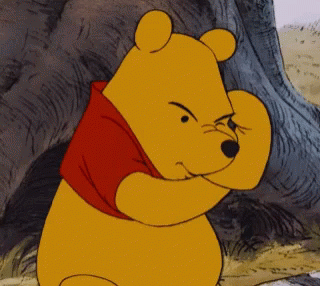
Reason #4: Word of mouth
Next, I took a look at the books I read because someone in my social circles told me to read them. But wait, how far of a net are we casting for “someone told me to read them?” Would my fifth-grade teacher count, since I technically read Haroun and the Sea of Stories because she gave me a copy as a going-away present when I had to transfer suddenly? Would a Booktuber count?
To make it easier on myself, I defined word of mouth reads as “Someone who knows my personal reading tastes/knows me personally and told me to read a book, either by giving it to me or telling me to read it and I went and looked it up on my own” Books I read because a Booktuber told me to read them are included in Reason #8 below!
And here’s a pie chart for you suckers:
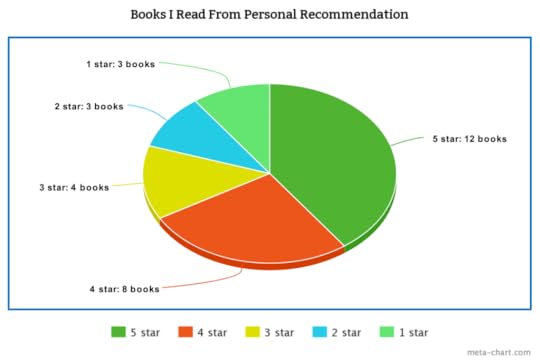
I also went through and tallied up who was the one to make me read it.
Books recommended/gifted to me by my parents: 14
Books recommended/gifted to me by a friend: 4
Books recommended/gifted to me by a teacher: 3
Books recommended/gifted to me by extended family, my students, etc.: 4
Of course, you would expect most of the gifted/recommendations to be from my parents, but I was surprised that all three of the recommendations I got from a teacher ended up being books I loved! These would include Haroun and the Sea of Stories, gifted to me by my fifth-grade homeroom teacher, Memoirs of a Geisha, recommended by my ninth-grade English teacher, and Buddha in the Attic, recommended by a college professor. Two of my one-star reads were “NYT Bestsellers” that my dad, when he’s not sure what else to get me, just buys the first fantasy book he finds on the NYT Bestseller list and calls it a day, and the third was a book my mom asked for as a Christmas present for the kids in her therapy program, but I read it first to make sure it was okay for the kids and it… really wasn’t a very child-friendly book, so I couldn’t give it to her. Again, take of that what you will.
Reason #5: Chance find
These books were ones that I found just randomly browsing the library or bookstore and found them on the shelf and was like “Huh, that looks good, I’ll read it.”
Again, to make it easier on myself, I defined “chance find” as a book I didn’t know existed prior to finding it in a physical brick-and-mortar place where one can buy or borrow books. This then allowed for library finds, thrift store finds, and even grocery store finds (my local grocery store had, for a few months, a “bargain book bin” that sold all sorts of books for $2-5 each and I bought a few of them)
Of my 225 books, I counted 61 that I read for this reason. 21 of them were library finds, 12 of them were bookstore finds, 27 were thrift store finds, and 1 was a grocery store find. I also counted the ones I read pre-book blog and post-book blog: 5 of those books were pre-book blog and 56 of them were post-book blog. Makes sense; before having a book blog, I didn’t even really use Goodreads or track my reading in any way, so it’s hard to remember any that I might have found randomly at the library or bookstore that I didn’t put on Goodreads when first making my account.
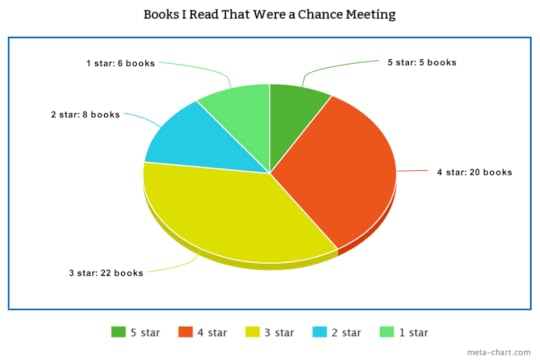
Reason #6: The Almighty Algorithm
A lot of times, I’ll be fooling around on Goodreads or Amazon and looking at a book and the site will say “Readers who enjoyed this book also liked this one!” and I’ll go look at it, mark it as Want to Read on Goodreads, and then buy it a little later and read it. I counted 22 books that I read because the algorithm told me I’d like it. Here’s the breakdown of that:
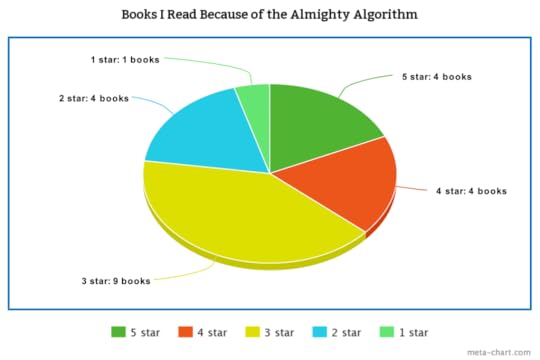
I wanted to do a “How many of the books the algorithm used as a recommendation for these did I enjoy?” (eg. did I enjoy the book I was looking at when the algorithm shoved this one in my face) but that is something I don’t remember. So instead, I looked at how much time passed between marking the book as “want to read” on Goodreads and actually picking it up and reading the book.
Now, this is a little hard to tell because I have a method on Goodreads where if I already have a book marked as “want to read” and then later acquire it, I will delete the original “review” and add it brand-new. This is because I have a shelf on Goodreads where I keep track of my actual physical TBR (called “TBR books I own”) to help differentiate from books that I do want to read, I just haven’t bothered to purchase them or get them from the library yet, and Goodreads has a very handy yet still annoying feature where you can sort books by “date added,” but it doesn’t differentiate “date added to Want to Read” and “date added to TBR books I own”. Thus, when I play my TBR game and get “Most recently acquired” and go to sort my Goodreads by “date added,” it doesn’t show me books I’ve bought recently that might have already been on my “want to read” shelf. So it’s a little harder to parse which ones were on Goodreads a while before I actually bought them and read them, but here’s my best estimation of that:
Books I read within 6 months of the algorithm showing them to me: 11
Books I read within 1 year of the algorithm showing them to me: 6
Books I read a year or more after seeing them on Goodreads: 5
Also something interesting I noticed here: books that I read within 6 months to a year of seeing them via the algorithm tended to be 4 and 5 star reads mostly, while books that were 1 year or beyond before I got around to reading them were mostly 3 stars or below. Of course, that’s partly probably because my reading tastes changed after so much time had passed, but I also want to think that sometimes the algorithm overreaches and shows me a book that really isn’t my cup of tea after all. And either way, I can easily think of contradictions to both sides of this argument, eg. books that I waited a year or more to read but still was very excited about reading them once I did get them in my hands, and books that I read almost immediately after seeing them via the algorithm but ended up only getting 2 or 3 stars from me.
Reason #7: Platform first
Next, I looked at books where I followed the author’s platform/like them as a person and wanted to support them by reading their book. There are not many of these, and I can count all of them on both hands.
A pop culture celebrity (TV star, movie star, etc.) wrote a memoir about their lifeI’ve read three of those sorts of memoirs. Those include There and Back Again: An Actor’s Tale by Sean Astin, which is a memoir of his experiences filming the Lord of the Rings trilogy; Gollum: How We Made Movie Magic by Andy Serkis, which is a memoir of sorts about his experiences filming the Lord of the Rings trilogy (are we seeing a pattern here? Dear Lord of the Rings actors: please more of you write memoirs about your filming experience! xD); and Finding Me: A Decade of Darkness, a Life Reclaimed by Michelle Knight, which is a memoir of her ten years as a s*x slave in Ariel Castro’s house. Astin and Serkis’ books both got 5 stars from me, and Knight got a 4 star rating from me!
2. They have a digital platform of some sort (Youtube, Twitter, etc.) and I follow them on social media
For this category, we have Show Us Who You Are by Elle McNicholl. McNicholl is an author who uses Twitter to talk about her books and about being autistic. I followed her on Twitter for a good while before getting her book and reading it. It was a 5-star read and made me cry so many tears!  We also have Eve: The Awakening and The Savior’s Champion by Jenna Moreci, a popular Youtuber who makes writing advice videos. I followed her channel for a while before she announced the publication of Eve, so that’s why I’m counting her here. Eve was a four-star read for me, although I first read it in 2016 and haven’t reread it since; I feel like if I were to reread it now, it might drop to 3 stars. The Savior’s Champion, however, was a 3-star read and I’m fairly solid with that rating; if I were to reread it at any point, it would remain 3 stars.
We also have Eve: The Awakening and The Savior’s Champion by Jenna Moreci, a popular Youtuber who makes writing advice videos. I followed her channel for a while before she announced the publication of Eve, so that’s why I’m counting her here. Eve was a four-star read for me, although I first read it in 2016 and haven’t reread it since; I feel like if I were to reread it now, it might drop to 3 stars. The Savior’s Champion, however, was a 3-star read and I’m fairly solid with that rating; if I were to reread it at any point, it would remain 3 stars.
In total, we have 6 books by 5 different authors.
Reason #8: Hype
A lot of my books that I’ve read were because of hype, whether that be from Booktube, Booktok, Bookstagram, Book Twitter, etc. For the purposes of this exercise, I count “hype” as “any bookish influencer, such as a literary agent, author, book reviewer, etc. posted about a book on their social media saying ‘It was good read it!’ and I read it because of that.” And in total, we ended up with 27 books.
Bet you guys missed the pie chart for #7 above, right? Well, here ya go!
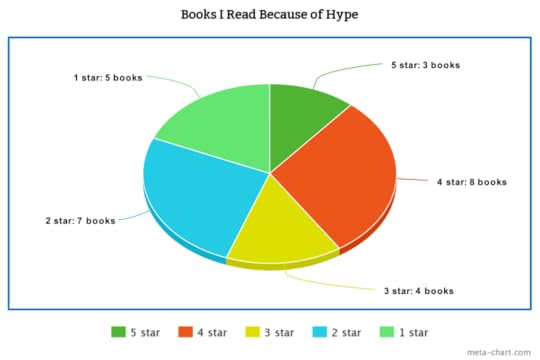
I also looked at the sources where I got these book recommendations. 15 of these books were from Booktube, 8 of these books were from Twitter, and 4 of them were from multiple sources. I don’t have accurate data from Booktok or Bookstagram, since I don’t really read many Booktok books and my Instagram feed is mostly cats or… yeah, it’s mostly just cats.
Reason #9: ARC
Looking specifically at books that were sent to me by the publisher/author for review (otherwise known as ARCs, or Advanced Reader Copy) we have 11 books to analyze.

(Unfortunately, there is no 5-star slice because I have yet to read an ARC that was a 5-star book for me! I have very high expectations for a 5-star read, which I may or may not delve into in another blog post in the future)
For these, I also looked at who made first contact. Were they solicited (aka I was the one to reach out to the author/publisher and be like “I would like to review this book”) or unsolicited (the author/publisher reached out to me first and said “Would you review this book on your blog?”)
Nine of my ARCs were solicited, and two of my ARCs were unsolicited. Both my unsolicited ARCs were physical copies, both were small press books, and one was a four-star read, the other was a two-star read. However, both of them, from the descriptions, etc, provided from the publisher, sounded right up my alley and I expected to love them. (and the four-star read is still one of my favorite books to this day and I shove it in everyone’s faces who wants a good fantasy rec!) Of my nine solicited ARCs, one was physical and the other eight were ebooks.
I also looked at those nine and where I solicited them from. Three of them were from a public post on Facebook groups for authors and readers (eg. an author posted in one the groups “Hey, I’m doing a blog tour, I need reviewers!”) five of them were from a private Facebook group specifically for my book review group The Naked Reviewers, and one of them I found on NetGalley. But the common thread is that all of them were solicited via a medium that already ensured it would be reaching readers/reviewers, rather than a generic post on someone’s Twitter or Facebook profile asking for readers.
Reason #10: Other
Of my 225 books, there were 6 of them I couldn’t fit in any other category. So I’ll break each of them down individually with star rating, why I read it, etc.
Well-loved classic
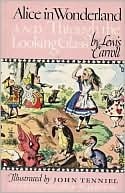
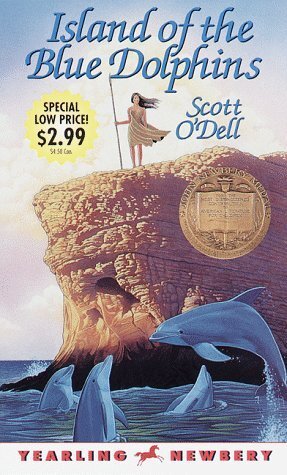

Three of all the books I’ve ever read would only be able to be classified as “it’s such a well-loved classic, I should read it.” (Of course, I’ve read more classics than just these three, but other classics fit under other reasons, such as adaptation, Booktube hype, etc.) These three didn’t really come from any other source other than “I want to read more classics. Oh, why didn’t I read these before? I should read them.”
Alice in Wonderland: 4 stars, Island of the Blue Dolphins, 2 stars, The Giver, 5 stars
Reading challenge

The Claiming of Sleeping Beauty I read because of a reading challenge to read a “banned book.” I Googled “banned books” and randomly chose this one. 2 stars. Also if you’re under 18, DO NOT look this book up. Just trust me on this one.
“Ten Books To Read To Escape to Japan” or something like that

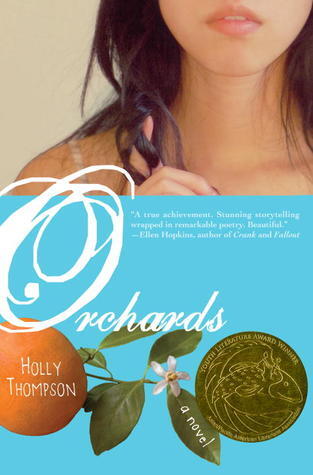
These two I read after Googling something along the lines of “Books where the character goes to Japan” or something like that. First thing I clicked on was a blog with a “books to read if you want to escape to Japan” sort of list with these two as top recommendations. My Awesome Japan Adventure by Rebecca Otowa and Orchads by Holly Thompson, both 5 star reads for me and I really recommend them!
11. Conclusion
What does this mean for you if you are an author reading this post and wondering how to get more people to read your book? Well, here is another pie chart for you, detailing all the reasons I went through above and seeing how many books I’ve read from that source:

It appears that most of my books that I read come from these three main sources:
Chance encounter at the library or bookstoreWord of mouth: a friend or family member tells me to read itHype on Booktube/Twitter/other bookish spacesAlso keep in mind that I try and read broadly from a variety of sources, eg. not only books that Booktube will tell me is good, but also books that my friends tell me are good and books that I discover on my own that I know my own reading tastes enough to say “yes, I will read and enjoy this book.” whereas other readers might strictly only go by Booktube recommendations, friends telling them what’s good, etc.
But you don’t just want one person to pick up your book, read it, and never talk about it. You want them to enjoy it enough to make other people read it, as well. For me, I consider four stars to be the level at which I will tell other people to read a book. So I took a look only at my four and five star reads and found that of the 225 books I analyzed for this post, 127 of them were either four or five stars, and therefore ones that I would tell other people about and recommend to them, which accounts for 56.44% of all the books I analyzed for this challenge. Here’s the breakdown of how many four and five star reads were from each source:

Most of my four and five star reads come from these three sources:
Word of mouth: a friend or family member tells me to read itChance encounter at the library or bookstoreChildhood rereadAlso remember that I am just one reader, so this is specifically how I get my books and how I figure out what to read. I remember when I was a child, I’d walk into my school library and think to myself “Wow! I want to read every single book that’s ever been written!” Because to me, my school library had “every single book that’s ever been written” and I was fairly confident I could read every single book in that library before I left to go to middle school. Now as an adult, I realize that that’s an impossible dream and you have to be a bit pickier about what books you read. But if I were to give advice to authors about how to get your book in the hands of readers (and considering that I’m also a writer and will have to eventually get my books in the hands of readers!) based on this data, the best way to get more people to read your book would be
Write a really good book that someone would read and say “Oh my gosh that was the BEST book I’ve ever read! I need to tell more people about this book!”Get your book into libraries and bookstoresWrite a really good book that transcends time and becomes a classic that people will read as a child and then reread again as an adultWrite a really good book that makes people want to pick up your backlist titles or look up your newest releaseHave a movie made of your bookHave your book promoted on Booktube, Booktok, etc.Write a really good book that you can send to book reviewers and they’ll rate highly and shove your book in everyone’s facesBe active on at least one social media platform (whichever one works best for you, whether it be Youtube, Instagram, Tiktok, etc.) and get people to like you for who you are. Or else become a major movie star in Hollywood and write a memoir about filming one of the highest-grossing films of all time xDIn almost all of the 8 above-listed ways, there’s one commonality that shines through: write a really good book.
Yes, it is that simple. Write a good book and the rest will follow.
Hopefully this gave you some ideas about new marketing avenues to explore, etc. This is a breakdown of my reading tastes, so if you for some reason specifically want me to read your book, just write a really good fantasy book that fits into my reading tastes and then make sure I know about it somehow. xD
That’s all from me today. Thanks for sticking with me through this longer-than-usual post. Don’t forget to check out my other social medias (found on my Linktree) and hit that big blue “Follow” button to get email updates when I make a new post!
Corinne 乙女
(Credit for header image: “Fairy Light” by charissa1066 is licensed under CC BY-NC-SA 2.0. To view a copy of this license, visit https://creativecommons.org/licenses/by-nc-sa/2.0/?ref=openverse.)



